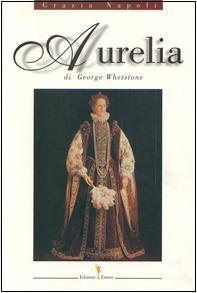

G r a z i a N a p o l i

|
|
|
|
|
|

|
Aurelia
by George Whetstone
Foreword by Aurelia Mastronardi.
Edited by Ermes, 2001 – Potenza.
Pages 242
Price 15,49 Euro
|
The book is a pretty elegant edition, with an opaque hardcover. An Elizabeth I Tudor image is composite with appropriate graphic symbols. The cover reminds us of style and colour of the Queen’s dress. At the back: a detail of the main image.
The book is divided into two parts and one Appendix.
The first part: places George Whetstone’s play Aurelia in a historical and literary period. The second part: a critical reading of the book, by synoptical sources. In Appendix: the comparative study with the first edition of the book, published 11 years before by the same editor with a different title and many differences, not only typographics.
The book is a modern version of the ‘500’s work, close (framed) in its rigid frame of elements: noble gentlewomen and gentlemen from different Countries; a noble Italian Palace; The Court of a Noble Italian Gentleman; the seven days of celebrations between Christmas and the New Year, in 1580. The author travelling in Italy happens to find himself by chance in the Palace. He travels like many learned young English men in the Elizabethan age. He is invited to stay there. The event goes on for seven days of celebrations in a courtly style of life. The Guests of the Palace are perfect Courtiers, like the ones Baldassarre Castiglione described in his book, very fashionable and well-known, at that time.
These Noble Gentlemen and Gentlewomen could dance and speak well; they had knowledge of arts; they loved theatre and had knowledge of philosophy and astronomy; they narrated Novelle with didactic and moral purposes.
The Novella is the centre of every reasoning, events and pleasures. This little, noble kind of writing encloses a short way of narrating life episode, symbolic aspects of life, well integrated in its historical period. Famous Novelles are drawn by Boccaccio, Bandello, Giraldi Cinthio; we can find the same Novelle that inspired Shakesperare and short stories by Margherita from Navarra, Ovidio, Virgilio e Omero. Everything is in a perfect frame, in a symmetric medieval system, like in the Frame of Decameron by Boccaccio, of Chaucer’s Carterbury Tales, and that of Eptameron by Margherita from Navarra. Every act or reasoning seeked the way to morality, trough Marriage glorification. It refers (referred) to the expected marriage of Queen Elizabeth. Marriage that never took place. The book include a protestant morality and a patriotic operation through perfect timing of the period when prose language was seeking its definition and Literature was not yet Shakespeare’s. It was the experimental period. It had since been a model for great Italian stories tellers of the ‘300s and ‘500s.
|
|
|
|